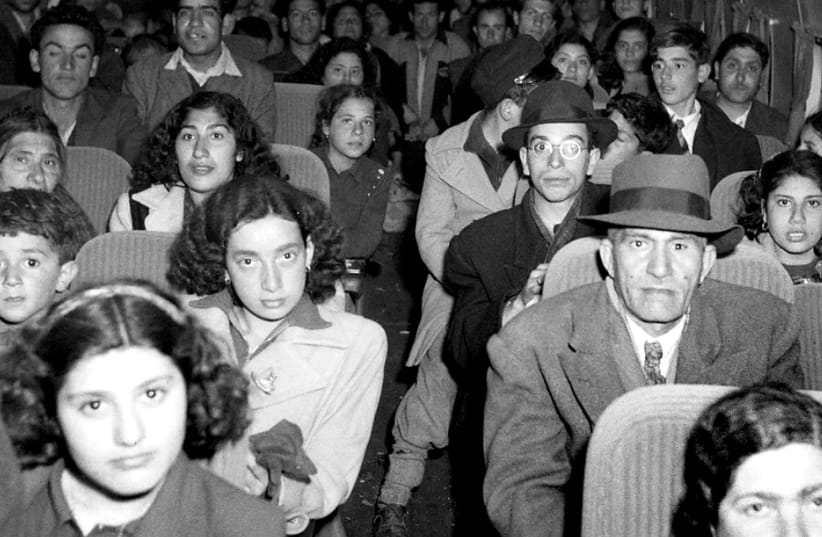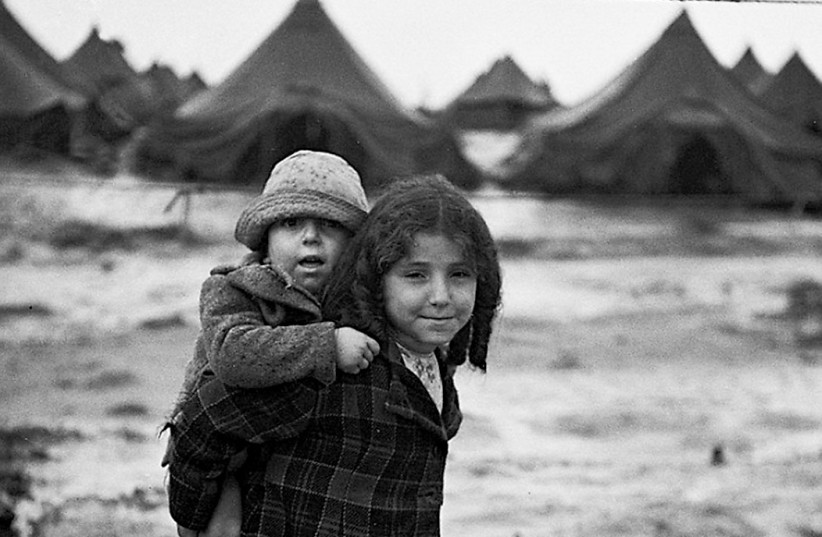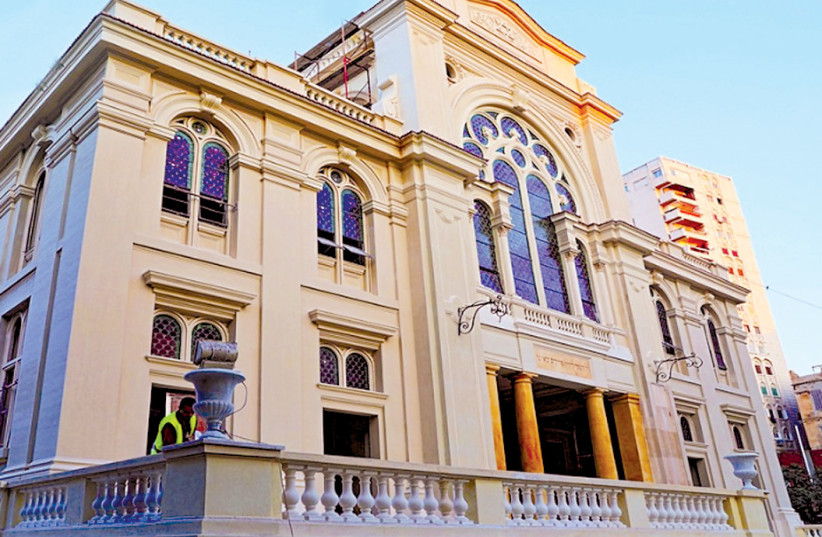During the Passover Seder, there is a ritual common in Sephardi families: The youngest children carry a napkin containing a piece of matzah tied around one shoulder. They leave the room and knock on the door.
“Who are you?” ask the adults at the table.
“The Children of Israel,” they answer.
“Where are you coming from?”
“Mitzrayim – Egypt,” say the children.
“Where are you going?” ask the adults.
“To Jerusalem,” the children respond as they resume their places at the table.
Egyptian Jews celebrating the Seder used to giggle at the notion of Jews leaving Egypt. After all, they were still sitting at a Seder table in Cairo or Alexandria. But in the second half of the 20th century, they were forced to leave, some at 24 hours’ notice. Today, Jews from Egypt refer to their “Second Exodus.” From a community of 80,000 only six remain.
The greatest story never told: Jewish exile from the Arab world
The story of the exiled Jews from Egypt is part of a larger story – that of the extinction of the ancient Jewish communities of the Arab world. It’s been called the greatest story never told.
More than 99 percent of Jewish residents – known as Sephardim (originally from Spain) or Mizrahim (Easterners) – have fled Arab states in the last 60 years. Some 650,000 went to Israel, and 200,000 to the West.
Communities which had tens or hundreds of thousands of Jews are nearing extinction. Syria and Iraq have three Jews apiece; Libya and Algeria, zero. Morocco has one percent of its 1948 population. Of a million Jews, only 4,000 Jews still live in Arab countries.
The exodus took two forms: Those better equipped with foreign passports and connections generally engineered their private exits, mainly to Europe, Australia or the Americas. Together with a minority of ideological Zionists, the rest went to Israel. Although the Diaspora remains overwhelmingly Ashkenazi, over 50 percent of Israel’s Jews today are Mizrahi or Sephardi refugees from Arab and Muslim countries or their descendants.
These Jews were effectively indigenous to the Middle East and North Africa. Their communities predate the Arab conquest and Islam by 1,000 years or more, and they made great intellectual contributions to Judaism itself. For instance, the Babylonian Talmud was elaborated in the pre-Islamic academies of what is today known as Iraq.
Mass refugee movements have been a feature of conflicts in the 20th century: More than 52 million people have been displaced. The Arab-Israeli conflict is no exception. Population exchanges were common in the 20th century; roughly equal numbers of Jews from the Middle East and North Africa, and Palestinian Arabs swapped places. (There were also exchanges of refugees between Greece and Turkey, India and Pakistan, and Greek and Turkish Cyprus, not to mention the mass migration of ethnic Germans and others in the wake of WW II.) Yet many people believe that Israel was created in response to the Shoah, and that Palestinian refugees were displaced to make way for Jews from Europe.
There is a myth that Jews and Muslims coexisted peacefully for 13 centuries until the establishment of Israel ruined the relationship. A cultural symbiosis existed, but Jews endured a precarious existence as inferior dhimmis [non-Muslims] under Islam. They had few rights and were at the mercy, or under the “protection” of the ruler of the day .
The dhimmi status was abrogated in the Ottoman empire in 1856, and Jews soon flourished under British, French and Italian colonial rule. It was to be a brief golden age, ended by the rise of antisemitism.
Arab nationalist parties, often inspired by Nazism, emerged in the 1930s. There was no place for Jews in their vision of independence. Jews were identified with the hated colonial powers, marginalized and , along with other minorities, denied a role in public life.
A three-way alliance among the Germans, the Mufti of Jerusalem Haj Amin al-Husseini, and the Muslim Brotherhood, financed by the Nazis, led to a campaign of incitement against the Jews of Iraq and Egypt, as well as in Palestine. The Mufti supported a pro-Nazi coup in Iraq in April 1941, leading to the massacre of hundreds of Jews, known as the Farhud. He spent the rest of the war as Hitler’s guest in Berlin, broadcasting poisonous anti-Jewish propaganda: “Kill the Jews wherever you find them!”
The Arab rejection of the 1947 Partition Plan for Palestine was accompanied by official threats against Jews living in Arab countries. Anti -Jewish riots broke out in Syria, Bahrain and Aden, and later in Egypt, Libya and Morocco. The five Arab League countries – Syria, Lebanon, Egypt, Iraq and Jordan – launched the 1948 war against Israel (Yemen and Saudi Arabia sent expeditionary forces).
The Arab League waged a second war against their own non-combatant Jewish citizens. They lost the war against Israel but won the war decisively against their own Jews.
Although Jews lived hundreds or thousands of miles from the theater of battle in Israel, they were singled out for persecution and dispossession because they were Jews. Arab League governments adopted discriminatory laws reminiscent of the Nuremberg laws. These scapegoated their Jewish citizens as “the Jewish minority of the state of Palestine.” Bank accounts were frozen, money extorted, Jews stripped of their civil rights, travel bans enforced, trading licenses revoked, and Jews forced to take on Muslim business partners. Above all, Zionism became a crime. Every Jew became a potential “enemy alien”: the flimsiest pretexts could be invoked to arrest, try and even execute Jews.
Although two refugee populations exchanged places, the circumstances of their displacement were very different. Palestinian Arab refugees were caught up in a war zone in 1948. The fact that 160,000 Arabs out of about 870,000 in western Palestine chose to stay indicates that the newly proclaimed Israeli state had no systematic policy of “ethnic cleansing.”
While Palestinian refugees were internally displaced a few miles away or relocated to countries which, like the great majority of them, were Sunni Muslim and Arabic-speaking, Jews were forced to abandon their property, their age-old heritage, languages and culture, and start afresh.
In 1948, the countries of the Maghreb, including Morocco, home to the largest population of Jews in the Arab world, were not yet members of the Arab League and were still under the colonial yoke, having not yet achieved independence. These countries were not contiguous with Palestine and their governments not at war with Israel, but their populations were, nevertheless, swept up in a powerful wave of anti-Jewish hostility.
Anti-Jewish riots had a grave psychological effect: Jews questioned if they had a future now that they had an alternative in Israel.
While Jews fleeing Nazi Germany found the gates to most countries shut in their faces, the establishment of Israel gave Jews fleeing the Arab and Muslim world – usually the poorest, frailest and most vulnerable – somewhere secure to go.
As soon as the State of Israel was established, the Zionist underground and the American Joint Distribution Committee, determined after the Holocaust never again to leave Jews in the Diaspora to their fate, rescued tens of thousands of refugees in some of the largest airlifts in history. When the pressure for emigration became unbearable, Yemen and Iraq made a deal with the Israeli Mossad to allow their Jews to leave.
The liberation by airlift was achieved with hard cash. In effect, Israel paid a ransom for each Jew, paying to transport them out of the country. Iraqi officials had to be bribed to the tune of several times their monthly salaries. It cost $14 a head to fly each passenger to safety.
When a five-year Moroccan emigration ban on Jewish families was lifted, an agreement was reached in 1961 whereby the World Jewish Congress paid a ransom of up to $250 a head to secretly transport Jews out of the country in the early 1960s, equivalent to $1,600 today. The total cost of the indemnities paid to the Moroccan authorities was somewhere between $5 million and $20 million.
The Iraqi government agreed to release its Jews because it thought that thousands of destitute people arriving on Israel’s doorstep with little more than the shirts on their backs would lead to economic collapse. Arab states and individuals reaped a short-term bonanza in Jewish assets seized and property deemed to have been abandoned or sold for peanuts. The long-term costs to the economy and culture of Arab states are unquantifiable.
The mass airlifts to Israel were unprecedented. The nightmare journey in a ramshackle cargo plane huddled with other air-sick passengers began well before the passengers stepped on board. Jews in Yemen made a long and risky trek on foot down to the British Crown colony of Aden: emissaries paid various Yemeni tribal chiefs a head tax to permit Jewish refugees to pass through the country. They arrived half-starved and destitute, and spent weeks in makeshift camps in the heat and dust. Some 150 died on the way, and 700 perished in the camps.
Some 4,000 of the 38,000 Jews in Libya had been made homeless by lethal riots in 1945 and had been sleeping in the synagogues. Around 120,000 Jews leaving Iraq were stripped by decree of their citizenship in 1950, and later of their property by a parliamentary law passed in secret session.
Jews in Egypt – the community numbered 80,000 – left in two main waves: 20,000, including communists and Zionists, in 1948; 25,000, comprising the middle classes, summarily expelled in 1956 and given just hours to leave with only 20 dinars in their pockets. All but 5,000 of the 30,000 Jews of Syria fled violent riots in 1947.
Many were marked for life by the trauma of their uprooting. Heads of families had had their work permits rescinded. Egyptian Jews remained haunted by the abusive or obscene phone calls they had received or calls with no one at the other end of the line; the threatening letters received; the bribes demanded; the ominous knock door at three in the morning, and the shock of armed men at the front door; male relatives taken away without explanation.
Plans for leaving had to be made in secret, without the usual goodbyes, especially if the final destination was Israel. When the time came for their hurried departure, Egyptian Jews would have their passports confiscated and replaced with a laissez-passer marked with the words: “One way – no return.”
Jews were stripped of their citizenship in Iraq and permitted to leave with 50 dinars ($80 today), one suit, a wedding ring, a cherished bracelet, a watch, and one suitcase. There was no guarantee that those suitcases would arrive at their destination. Departing Jews complained that malicious customs officers would confiscate a last piece of jewelry, ransack their bags or ruin the contents. Iraqi Jews, too, carried documents marked “One way – no return.”
Having reached safety, the refugees faced the challenge of building their lives all over again. The mental and physical cost was considerable. There is anecdotal evidence that a shocking number died soon after displacement, unable to cope with the trauma of uprooting and the stress of providing for their families.
Fathers especially found their authority suddenly eroded in a society less patriarchal than the one they had come from. Men who were merchants or administrators in their country of birth took off their suits and joined construction crews. Women went out to work for the first time and were often more resilient to change.
Relationships were turned upside down, with children taking responsibility for their disorientated parents. Refugee families were atomized and siblings dispersed across the globe.
Naturally, the harsh conditions awaiting the 650,000 Jews who went to Israel – the fetid ma’abarot (transit camps), the shortage of food and jobs, the new language and alien culture – were hardly encouraging. Israel was struggling to cope with an influx of refugees and Holocaust survivors, which doubled its 600,000-strong population overnight. The camps slowly turned into permanent towns and cities.
In spite of the hardships and suffering of the early years, these Jews had escaped anti-Jewish riots, synagogue burnings, kidnappings, internment and executions. Today, no Jew still considers him or herself a refugee. Jews from Arab and Muslim countries are represented in every field of endeavor in Israel, in the government and the army.
The few thousand Jews, usually the wealthier ones, who stayed behind in Arab countries congratulated themselves at the time that they had not joined the mass exodus. For a short period, they continued to live calm and comfortable lives. But even worse torment lay in store for them: Jews in Egypt were brutally expelled after 1956, and scores were imprisoned after 1967; Jews in Iraq were publicly hanged in Baghdad in 1969, and up to 50 vanished without a trace.
A blessing in disguise, but a story gone forgotten
At this year’s Seder, Jews with roots in Arab and Muslim countries might be reflecting, in spite of all the hardships, that the exodus was a blessing and a liberation from persecution. No Jew wants to go back. Some have done well for themselves. The story is told of the Egyptian Jew who insisted on visiting the tomb of Egyptian president Gamal Abdel Nasser and said: “Thank you, Nasser; for if you had not expelled me, I would not have become a millionaire.”
Until the mass flight of Middle Eastern Christians after the 2003 invasion of Iraq, the largest number of non-Muslim refugees in the Middle East and North Africa were Jewish. They outnumbered Palestinian Arab refugees from what is now Israel.
The vast majority will be unequivocally thankful that they got out and rebuilt their lives in the free world.
Many are, however, increasingly frustrated that their story has been neglected or forgotten.
The world has ignored the Jewish refugee story and the Jewish quest for justice. Not only have the refugees had to fight to be recognized as refugees, but they have never been compensated. It is estimated that Jewish assets lost amount to hundreds of billions of dollars. Property and land seized or abandoned in Arab states amount to the size of Jordan and Lebanon combined.
If we are ever to reach a point of reconciliation, everybody needs to be aware of the plight of Jews from Arab countries and the injustice done to them. They are also key to debunking the myths about Israel that have been allowed to take root during decades of silence.
Too many people are in denial about Arab and Muslim antisemitism, the engine of “ethnic cleansing” within the region. The story is not just a niche Sephardi or Mizrahi one – it is more relevant than ever to an understanding of the Arab/Islamist struggle against Israel. ■
Lyn Julius is the author of Uprooted: How 3,000 Years of Jewish Civilization in the Arab World Vanished Overnight (2018) and co-founder of Harif, an association of Jews from the Middle East and North Africa in the UK.


